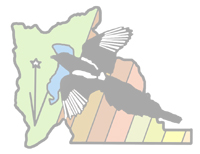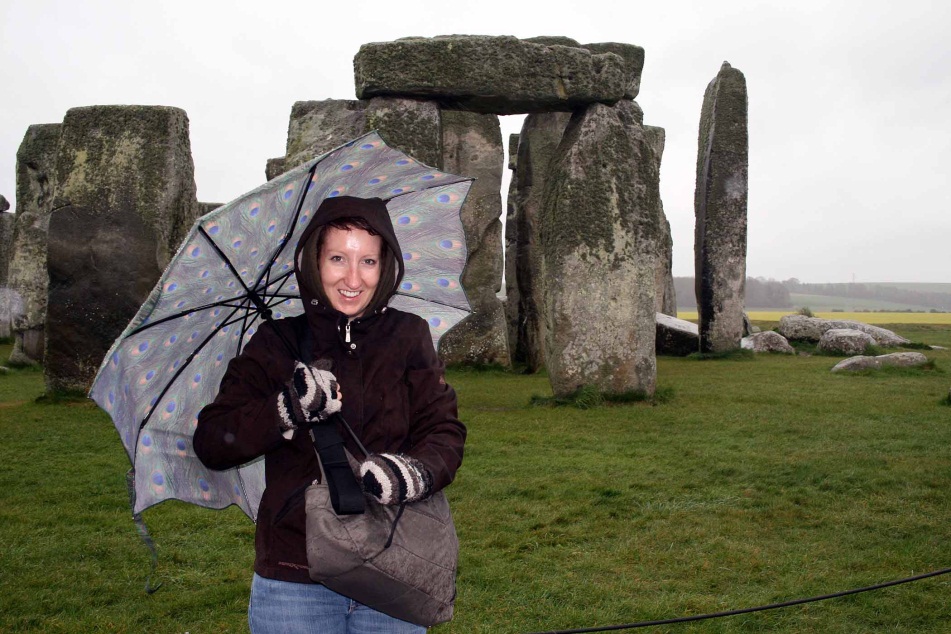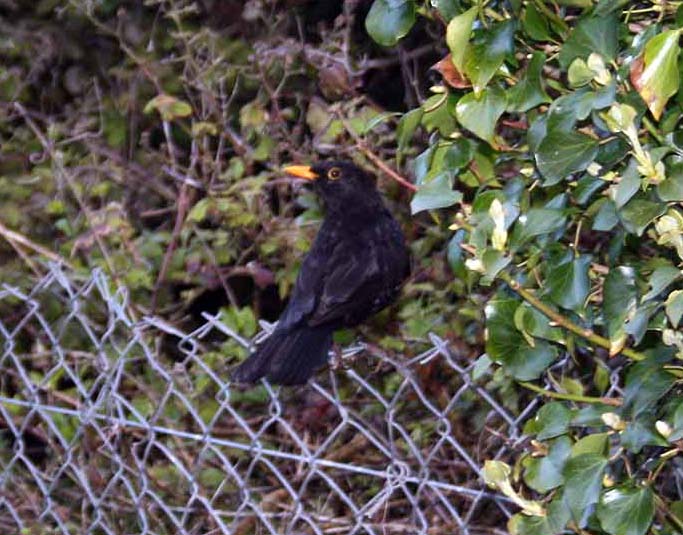Utah County Birders Newsletter
|
 |
Contents
February Meeting
Upcoming Field Trips
Captains Log
Bird of the Month
Field Trip
Report - Farmington Bay
Website -
Our Photo
Gallery
Backyard Bird of the Month
January Hotline Highlights
Newsletter is now
Online Only
FEBRUARY MEETING:
Thursday, February
14th, 2013 - 7:00 PM (note new meeting place)
Kylan Frye from the nonprofit conservation
organization Hawkwatch International will give a presentation titled
"Raptors and Invasive Species: Landscape-scale
conservation in the West Desert" She will also give a quick
introduction to what Hawkwatch's mission is and what they do.
Meet at 7:00 PM at the Orem Public Library - 58 North State Street, Orem.
------------
Note - meetings will be held at the Orem
Public Library while the Bean Museum is under construction.
9 Feb 2013 (Sat): Bald Eagle Day. A DWR Wildlife Event. Come and go as you wish at any of the Bald Eagle Day locations. The ever-popular Bald Eagle Day will be on Saturday, February 9, 2013 at five locations. The times vary according to the location and are as follows: Salt Creek Waterfowl Management Area from 10 a.m. to 3 p.m., Farmington Bay Waterfowl Management Area from 9 a.m. to 4 p.m., Fountain Green State Fish Hatchery from 9 a.m. to 4 p.m., Split Mountain/Green River from 9 a.m. to 4 p.m., Cedar Valley from 3 p.m. until dusk.
18 Feb 2013
(Mon):
East Bay, Kuhni Wetlands Trail, and the Provo Cemetery.
8:30-12:30. led by Keeli Marvel. Meet at 8:30 AM at the Provo Sam's Club.
We are actively recruiting people to lead local half-day field trips, any time,
any place. If you would like to lead a field trip or if you have any ideas for
this year’s field trips, please contact Bryan Shirley at -
bt_shirley@hotmail.com
February Captains Log
by Keeli Marvel
 |
|
Stonehenge |
 |
|
a very polite yield sign
in England |
 |
|
a Blackbird |
Birding England Part 1:
Last year I was lucky to spend a milestone birthday (30 years young) in England
with my mom and my sister. This was not my first trip over there, but it was the
first that I got serious about seeing birds while I was there. I was the only
birder in the group, and this was not a birding trip, but I still managed to
tally some 40 life birds while I was there. One of the curious things I
discovered while researching the species I would be on the lookout for was the
simplicity of the bird naming system in England. Blackbird. Robin. Wren.
Goldcrest and Firecrest (Similar to our Golden and Ruby-crowned Kinglets).
Dunnock. Blackcap. Skylark. Linnet. And the list goes on…. It’s almost like they
were the first to name the species, and all those that came after felt the need
to embellish upon their concise and simplistic naming system.
My first few hours off the plane I saw House Sparrows and Blackbirds. The
English Blackbirds are ubiquitous over there, and are not related to the
blackbirds we are familiar with. In fact, I believe they are in the thrush
family, and are more closely related to our American Robin than to any of the
species in the US that we identify as blackbirds. As common as they are, I was
still excited to see them – glossy black birds with bright orange beaks.
The first couple of days we spent visiting our friend Mark’s son at the
University of East Anglia in Norwich. We took a narrow gauge (miniature) train
ride to a town called Wroxam in Norfolk County, and then a boat ride along the
Broads, a series of small man-made lakes created when the peat bogs were mined
back in medieval times. This was a great place for water birds. I saw what I
believe were non-domesticated Graylag geese, Mute Swans, and Egyptian Geese,
Common Pochard (very similar to our Redhead), and Tufted ducks, Gray Heron (very
similar to our Great Blue Heron), to name a few. The highlight of this boat
trip, by far, was the Great Crested Grebes. They are similar to our
Western/Clark’s Grebes, but they had cute ear tufts, and reddish flaps below
their cheeks. What an amazing grebe! One of two species of Martin in England,
the House Martin, was there as well, cruising around over the lakes in mixed
flocks with Barn Swallows. Back at the docks I identified Common Terns, Herring
Gulls, and Black-headed Gulls as well. On the walk back to the train station I
identified three more species: the Robin (or European Robin as we identify it),
the Chaffinch, and the Greenfinch. The European Robin bears little resemblance
to our Robin. It is a much daintier bird with a pale reddish face and breast
usually found skulking around in and under bushes. The Chaffinch is a fantastic
bird with blue-grayish and reddish coloration that reminds me of the colors on a
male American Kestrel. The Greenfinch is not in fact green, but is yellow and
reminiscent of American goldfinches.
Following our stay in Norwich, we traveled all the way down to the western coast
of England to stay in a small fishing village called Padstow for a few days. We
went by way of Stonehenge, where it was pouring rain- often sideways-a theme we
were to become familiar with over the next week. I’d spent a month during the
summer in Padstow after my first semester in college, so it always feels like
going home when I get back there. We were there to celebrate May Day, which the
town celebrates with unique local traditions dating back hundreds of years.
While there, I got to spend some time wandering along the coast path that
follows the harbor out along an inlet to the coast. It is along this path I
first saw a Linnet, a bird similar to our house finch.
The area surrounding the old stone church in Padstow is wooded and has a stream
running through it, and was the perfect place to pick up a few more species.
England is home to a whole family of birds related to our chickadees, which they
call Tits, and which seem to have diversified a lot more colorfully than ours.
In the Padstow churchyard I found Great Tits and Blue Tits, both vibrantly
colored with yellows, blues, and greens. I also found a Willow Warbler flitting
around well camouflaged in the tree canopies. In contrast with the Tits, the
warblers of England are a very bland and hard-to-identify group characterized by
mostly muted yellows, browns, and grays (think flycatcher identification, and
you get the idea). I spotted a Blackcap skulking in the reeds along the stream,
which indeed has a black cap, and reminded me of our gray catbirds. The entire
time I was birding in that area, I kept hearing a loud, almost obnoxious
rattling flight call which I finally located and identified as a Mistle Thrush.
Their song is melodic and reminiscent of an American Robin’s singsongy call, but
their flight call reminds me of something more along the lines of a cicada.
To be continued next month…
American Kestrel (Falco Sparverius)
by Jeff Cooper
A few years ago when I first started rekindling my childhood interest in birds I
was browsing through a field guide to the birds of North America and came across
a bird called American Kestrel. I had never heard the word "kestrel" before and
I had no idea where such a bird would exist (other than the obvious reference to
“America”). I remember reading that it was the "most colorful falcon" in North
America. The picture I was viewing was certainly colorful, especially the male.
I remember thinking I would love to see one of those guys. Little did I know I
simply needed to become aware that the bird existed and then point my eyes in
the right direction when I took my usual walk along the canal near my home. I
saw my first-ever Kestrel sitting on a power line and was awestruck by its
colors. I'm sure I've seen a thousand since that first time, but I still take
time to admire them.
American Kestrels are the smallest falcons in North America. They appear across
the United States, but they are much more common in the western states. They
prefer open habitats such as grasslands, meadows, and farm fields. They are
often seen perched on power poles and power lines and frequently pump or bob
their tails while perched, especially after just after landing. Kestrels nest in
cavities and will nest in bird houses. They occupy very small territories and
are often seen hover-hunting above those territories. Kestrels are opportunistic
when it comes to eating. They are excellent mousers and will eat insects, small
reptiles, and other birds. The image below is of a male as it was hover-hunting
over a small field.
|
|
Female Kestrels show brown streaking on their chests. Males have cleaner chests with a soft salmon color above and a few spots on their sides. The females have rufous (rusty) and black barring on their wings and back. Males have distinctive blue upper wings with black markings. Both males and females have distinctive face patterns that include two black stripes. Both sexes also show "false eyes" on the backs of their heads. This is believed to help deter possible predators that may be approaching from behind. Here are some images showing the differences between the two sexes.
|
|
|
The photos below show some of the differences between the two sexes when seen from below. The male's tail feathers show a broad dark terminal band. The female shows banding throughout the tail feathers. Again, the male has a cleaner chest with a soft salmon color at the top and a few spots along the sides where the female shows streaking throughout the chest.
|
|
|
This article was condensed from a post I originally published on my blog:
http://neovistabirding.blogspot.com/2013/01/american-kestrel-small-but-colorful.html
If you would like to
write an article for the Bird of the Month, please contact
Eric Huish -
erichuish@gmail.com
Click here for past 'Birds of the Month'.
Field Trip Report
Farmington Bay - February 2nd, 2013
Bryan Shirley
Today on the Utah County Birders Field Trip 5
birders headed North to Farmington Bay (I think the fog/4 degree start time on
our last field trip scared everybody else away!) We got to Farmington a bit
after 8. It was pretty foggy and tough to find birds. We saw a lot more
photographers than eagles, but found a few eagles too. We saw 1 Herring Gull and
it was the only gull we saw there all morning. From Dave Wheeler's report it
sounds like it was better in the afternoon.
From there we went out 12th street in Ogden to try our luck with the Horned Lark
flocks. I thought there were a lot
fewer birds than when I was there last month, but we easily located several Snow
Buntings (6 total) and 1 Lapland
Longspur. The longspur was getting quite a bit of color - pure rufous nape and a
fair amount of black in the front.
Unfortunately it took off before everybody got to see it and we couldn't
relocate it.
Our next stop was in Croyden for Redpolls. We watched the feeders for about an
hour or so and had small groups of
Common Redpolls, but no Hoary (others had seen at least one earlier in the day).
Thanks again Weston for reporting them and letting us visit.
Finally, we stopped at Deer Creek for a good variety of Waterfowl including 1
Trumpeter Swan, 2 Tundra Swans, all 3 merganser species, and all the other
common ducks.
Our Photo Gallery of North American Birds
by Milt Moody
We no longer just deal with the birds of Utah in our "Photo
Gallery." We're going for the whole North American Continent! So far we've
added photos of 73 new non-Utah species and these are not just ordinary photos.
John Crawley's photo of a breeding male
Magnificent Frigatebird in Ecuador with a pumped up throat pouch is as
artistic as it is interesting and exotic. The
Tufted
Puffins on a cliff in The Pribilof Islands of Alaska taken by James McIntyre
are balanced by Bryan Shirley's pair of
Atlantic
Puffins taken on the other side of the continent. Both photos are absolutely
gorgeous! We're getting pictures from all over the world in exotic places taken
by exotic people. A picture of
Royal
Terns taken in Florida by Jari Uitto, a Finnish birder with connections in
Utah, was added to the
Royal
Tern photos taken by Mia McPherson taken when she was living in Florida.
Kendall Brown continues to cover the globe taking pictures of a
Gila
Woodpecker in the Phoenix area,
Black-headed Gulls in Cumbria, England,
American Oystercatcher in both Massachusetts and Peru (John Crawley also
sent in oystercatcher photos from Ecuador).
We're still getting great pictures taken right here in Utah -- pictures of rare
birds such as a juvenile
Baltimore Oriole that showed up in Salt Lake City that Jack Binch
photographed, and some
Mountain Plovers that are trying to survive the cold snowy weather taken by
Paul Higgins. We're getting close-ups of
Sharp-shinned Hawks by Ted Fitzgerald (a different kind of "bird's eye
view") and some of
Common Redpolls taken by Paul Higgins and Jack Binch. We've even got a cover
page photo for a "Bird Romance Novel" section of the website with John Crawley's
photo of a pair of
Wood Ducks.
or should we use one of the
House
Finch photos by Kendall Brown and Wade Reed OR the
Western Grebe photos by Joe Ford, Shon Reed, Ted Steinke and Kent Keller?
(All we need now is for someone to write a bird romance novel -- who knows, the
idea just might fly!).
If you have taken pictures of non-Utah North American birds that you'd like to
share, please send them in. It's pretty exciting to see all these new species
and great photos showing up in our
Photo Gallery.
January 2013
Jeff Cooper - Pleasant Grove
My favorite yard bird in January was a new bird to my yard list--Townsend's
Solitaire. It flew into the Eastern Redbud tree right outside my kitchen
window just as I looked out the window. It was gone within a couple of seconds
so it was perfect timing for observing a new yard bird.
Eric Huish - Pleasant Grove
White-winged Dove - saw it for a moment in the top of a tree in the
across the yard. Probably the same bird that visited last September and
has been hanging out at some feeders down the street.
Milt Moody - Provo
A couple of Pine Siskins came to my thistle feeder with the Lesser
Goldfinches. I've been hoping a redpoll or two would come in with the siskins,
but so far...no luck.
Carol Nelson - Provo
While I was home, the Bald Eagle spent a couple of days sitting in his
usual Cottonwood perch and a Red-breasted Nuthatch made an infrequent
appearance in the pine outside my window-a good home birding day. Another day
brought 3 Great Blue Herons on one side of the pond and a Red-tailed
Fox on the other side. That sighting held my attention for quite a while.
Leila Ogden - Orem
I've been watching my feeders more closely looking for a redpoll. Well I never
found one, but I did see a new yard bird for a brief minute. It was a
Red-breasted Nuthatch. I have Never seen one in my yard before, but was
happy to see it now.
Cheryl Peterson - Provo
Townsend's Solitaire - new yard bird
Leena Rodgers - Provo
My best yard bird for January was a handsome American Kestrel hovering at
the feeder outside my patio window. First time I've spotted one in our yard.
Alton Thygerson - Provo
Red-breasted Nuthatch - This is a surprise bird--wish it would come more
than the couple of times I've seen it.
Report your favorite backyard bird each month to Eric Huish at 801-360-8777 or erichuish@gmail.com
Newsletter Announcement. The Utah County Birders Newsletter is now online only.
We've decided to stop the regular paper "snail mail" version of the UCB Newsletter. This will save our club on Printing, Postage and Paper. If you would like an email notice each month when the Newsletter is posted online please send an email to Eric Huish at erichuish@gmail.com or subscribe to the ucbnet mailing list. To subscribe to ucbnet just send an e-mail to ucbnet-subscribe@utahbirds.org
We are willing to print the online version of the newsletter and mail it out to anyone who still wants a paper copy or who doesn't have internet access. If you know of anyone who enjoys the UCB Newsletter but doesn't have internet access please let Eric Huish or Keeli Marvel know and we will make sure they get a copy.